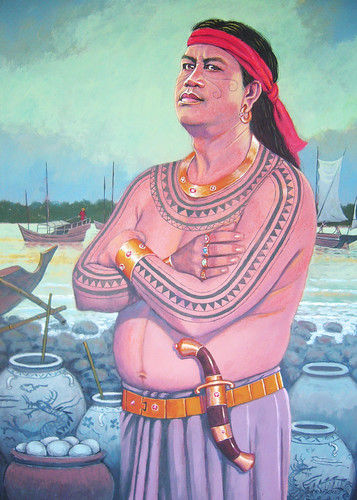Socio-cultural had its biggest influence in the reign of the Spaniards here in the
The first well-known Catholic in the

An artists interpretation of Rajah Humabon of Cebu
Here are some crises that they faced during the reign of Catholicism in the
1. Geography- since the Philippine archipelago is made out of 7,000+ islands It was very hard for them to expand Catholicism especially when they lack resources. But still missionaries didn’t lose hope instead they walked through the mountains just to spread Christianity to Filipino men.
2. Language- It also became a major problem because during the colonization of the Spaniards most of the people were taught how to speak in Spanish but still many can’t. So, they cannot understand the readings and teachings of the church for it was written and said in Spanish. Also, there are many languages in the
3. Religious beliefs- Filipinos had this cultural and religious beliefs even before the Spaniards came. Like life after death, God or “anito” The spirit of heavenly bodie such as moon, starts, sun, mountains, lake. Etc. They also have this “babaylan” or a girl priest some missionaries believe that a babaylan is from the power of the demons. But there are still a number that believe in those religious criticisms.

An Anito Structure
4. Lack of men and support- Basically, they lack people to travel from one region to another to spread Christianity. Plus the fact that they don’t have enough resources to travel. Also the financial support from the Spaniards. In the
Characteristics of Catholicism:
Beneath the conflicts of teaching Catholicism Spanish missionaries didn’t lose hope instead, they agreed that they will teach Catechisms with the peoples own language. Addition to this was the “reduccion” system to make work easier for contemplating.
Reduccion System:
It was a resettlement policy employed by the Spaniards which was designed for a convenient administration of the colonies. The Spanish authorities enticed the natives to live near the churches or within hearing distance of church bells (in Spanish: bajo de la campana). Looking back, Christianity was introduced based on the Filipino natives' familiarity in animist belief. The faces of the anito and diwata were changed to that of the great saints. The horrifying creatures, such as aswang and kapre were transformed to devils in Christian faith. Fiestas and festivals, then as native ritual feasting, were celebrated in honor of the town's patron saint. Some natives remained firm, not obeying this Spanish imposition. Such were called vagamundos.
Use of Language:
Of all the Languages used in the regions the missionaries agreed to teach the people the Native language. Nonetheless, the people soon learned how to write and teach catechisms in their own languages. With this, the exploitation of Catholicism is being widely spread. As Vicente L. Rafael said, the configuration of the priests to the concept of Catholicism in the Tagalog language is important during the colonization of
Different orders of priests were given where they choose to built their own parishes. The priests learned the language where they raised they parishes and most of the time they were the ones who translate and spread the Christian beliefs in their community. Like:
·Augustinians (1565) Bulacan, Batangas, Pampanga, Ilocos, Cebu, and
·Franciscans (1578)
·Jesuits (1581) Rizal,
·Dominicans (1587) Batanes, Nueva Vizcaya, Cagayan, and Pangasinan